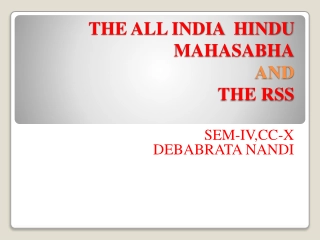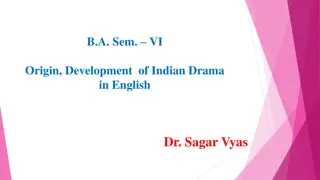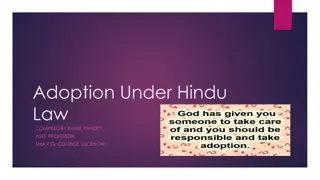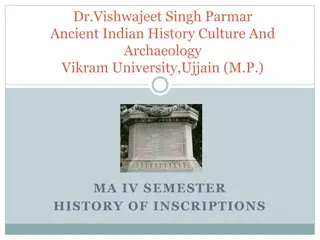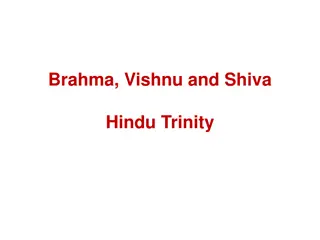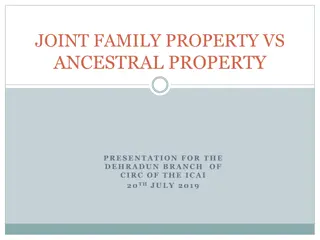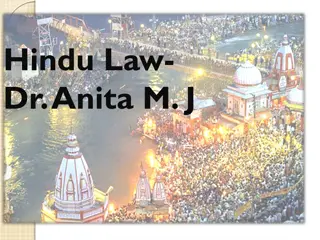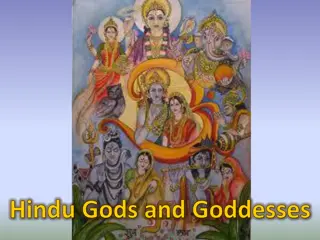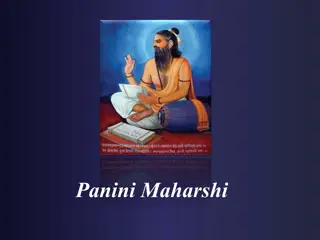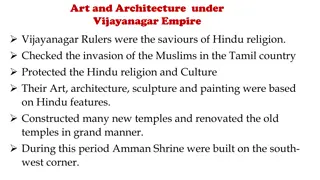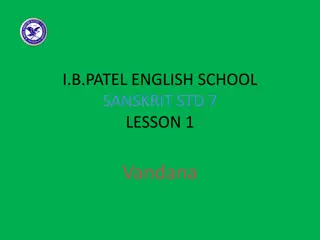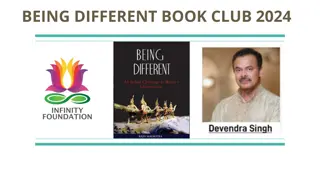Hindu College Guntur Department of Sanskrit - Sraddhatraya Vibhaga Yogam Introduction
The introduction provides insights into the department of Sanskrit at Hindu College Guntur, highlighting the significance of Sraddhatraya Vibhaga Yogam and the 17th chapter of the Sreemadbhagavadgeetha. It explores the role of Vyasa in Hindu traditions and his association with the Mahabharata, shedding light on the historical background of the text and the essence of the Shrimad Bhagavad Gita.
Download Presentation

Please find below an Image/Link to download the presentation.
The content on the website is provided AS IS for your information and personal use only. It may not be sold, licensed, or shared on other websites without obtaining consent from the author.If you encounter any issues during the download, it is possible that the publisher has removed the file from their server.
You are allowed to download the files provided on this website for personal or commercial use, subject to the condition that they are used lawfully. All files are the property of their respective owners.
The content on the website is provided AS IS for your information and personal use only. It may not be sold, licensed, or shared on other websites without obtaining consent from the author.
E N D
Presentation Transcript
HINDU COLLEGE GUNTUR DEPARTMENT OF SANSKRIT Sraddhatraya Vibhaga Sraddhatraya Vibhaga Yogam 17th chapter of 17th chapter of Sreemadbhagavadgeetha Sreemadbhagavadgeetha 3 3rd rdunit unit Chapter Chapter- -2 2 Degree 3rd Sem Degree 3rd Sem Yogam
Authors Introduction:- Krishna Dvaipayana better known as Vyasa or Vedavyasais a central and revered sageportrayed in most Hindu traditions. He is traditionally regarded as the author of the Mahabharata. He is also regarded by many Hindus as the compiler of a number of significant scriptures. As a partial incarnation, Amsa Avatar of Vishnu, he is also regarded by tradition as the compiler of the mantras of the Vedas into four Vedas, as well as the author of the eighteen Puranas and the Brahma Sutras. He is one of the seven Chiranjeevis. As per Indian Mythology Vyasa is the author while Lord Ganesha is the Scriber of Mahabharata which is the root book of ShrimadBhagavadGita.
Root text Introduction:- The Shrimad Bhagavad Gita often referred to as the Gita,is a 700-verse Hindu scripture that is part of the epic Mahabharata (chapters 23 40 of book 6 of the Mahabharata called the Bhishma Parva), dated to the second half of the first millennium BCE and is typical of the Hindu synthesis. It is considered to be one of the holy scriptures for Hinduism.
Historical background of the text: Historical background of the text:- - After the exile to forest (Vanavasa), the Pandavas After the exile to forest (Vanavasa), the Pandavas sent embassy to Dhritarashtra for their share in sent embassy to Dhritarashtra for their share in the kingdom. At first, the priest of Drupada went the kingdom. At first, the priest of Drupada went as the ambassador of the Pandavas and asked as the ambassador of the Pandavas and asked for the share in the kingdom. Sanjaya who went for the share in the kingdom. Sanjaya who went as the ambassador from the side of the as the ambassador from the side of the Kauravas did not announce the result. He said it Kauravas did not announce the result. He said it was Dhritarashtra's message that all of them was Dhritarashtra's message that all of them should live together. Then the Lord Srikrishna should live together. Then the Lord Srikrishna himself approached them as the peace embassy himself approached them as the peace embassy on behalf of the Pandavas and asked for the on behalf of the Pandavas and asked for the share in the kingdom. Yet Duryodhana denied to share in the kingdom. Yet Duryodhana denied to give even a bit of land to the Pandavas. The war give even a bit of land to the Pandavas. The war became inevitable. The army of seven became inevitable. The army of seven Akshauhinis on the Pandavas' side and the army Akshauhinis on the Pandavas' side and the army of eleven Akshauhinis on the Kauravas' side of eleven Akshauhinis on the Kauravas' side were ready. were ready.
Context of the text Context of the text: :- - At the outset of the At the outset of the war, Arjuna beheld war, Arjuna beheld once the venerable once the venerable elders and his kinsmen elders and his kinsmen Bhishma, Drona and Bhishma, Drona and the like, he dropped the like, he dropped down his bow out of down his bow out of remorse and said that remorse and said that he would not fight the he would not fight the war. war.
Main context of the Chapter: Main context of the Chapter:- - Then Srikrishna taught Arjuna the Bhagavadgita consisting of 18 Then Srikrishna taught Arjuna the Bhagavadgita consisting of 18 chapters with 700 verses to elucidate him his duty. As the answers chapters with 700 verses to elucidate him his duty. As the answers given by the Lord to the questions asked by Arjuna on each topic are given by the Lord to the questions asked by Arjuna on each topic are in 18 sections, those enlightening and didactic chapters are called in 18 sections, those enlightening and didactic chapters are called Yogas. Thus the Lord taught the Bhagavadgita in 18 chapters and 18 Yogas. Thus the Lord taught the Bhagavadgita in 18 chapters and 18 Yogas. 1) Arjuna Vishada Yoga, 2) Sankhya Yoga, 3) Karma Yoga, 4) Yogas. 1) Arjuna Vishada Yoga, 2) Sankhya Yoga, 3) Karma Yoga, 4) Gnana Karma Sanyasa Yoga, 5) Karma Sanyasa Yoga, 6) Atma Gnana Karma Sanyasa Yoga, 5) Karma Sanyasa Yoga, 6) Atma Samyama Yoga, 7) Gnana Vignana Yoga, 8) Akshara Parabrahma Samyama Yoga, 7) Gnana Vignana Yoga, 8) Akshara Parabrahma Yoga, 9) Rajavidya Rajaguhya Yoga, 10) Vibhuti Yoga, 11) Viswarupa Yoga, 9) Rajavidya Rajaguhya Yoga, 10) Vibhuti Yoga, 11) Viswarupa Sandarsana Yoga, 12) Bhakti Yoga, 13) Kshetra Kshetragna Yoga, Sandarsana Yoga, 12) Bhakti Yoga, 13) Kshetra Kshetragna Yoga, 14) Gunatraya Vibhaga Yoga, 15) Purushottama Prapti Yoga or 14) Gunatraya Vibhaga Yoga, 15) Purushottama Prapti Yoga or Viswarupa Yoga, 16) Daivasura Sampad vibhaga Yoga, 17) Viswarupa Yoga, 16) Daivasura Sampad vibhaga Yoga, 17) Sraddhatraya Vibhaga Yoga, 18) Moksha Sanyasa Yoga.thing line Sraddhatraya Vibhaga Yoga, 18) Moksha Sanyasa Yoga.thing line abodeAmong them, the seventeenth chapter of the Bhagavadgita is abodeAmong them, the seventeenth chapter of the Bhagavadgita is Sraddhatraya VibhagaYoga. Sraddhatraya VibhagaYoga.
Essence of Sraddhatraya Vibhaga Yoga: Essence of Sraddhatraya Vibhaga Yoga:- - Arjuna said to the Lord: What is the position of those that Arjuna said to the Lord: What is the position of those that neglect the rules of the Vedas, yet worship with faith? Is neglect the rules of the Vedas, yet worship with faith? Is such worship considered to be in the mode of goodness, such worship considered to be in the mode of goodness, passion or ignorance? passion or ignorance?
Listening to this question, the Lord replied: There are three divisions of faith (1) sattva, (2) Listening to this question, the Lord replied: There are three divisions of faith (1) sattva, (2) rajas and (3) tamas.Those having the sattva quality worship the gods; those having the rajas and (3) tamas.Those having the sattva quality worship the gods; those having the quality of raja worship the demi quality of raja worship the demi- -gods and ogres; and other people possessed of tamas gods and ogres; and other people possessed of tamas worship ghost and the hosts of spirits. Those who do not follow the procedure of the science worship ghost and the hosts of spirits. Those who do not follow the procedure of the science and attract the ghosts etc by performing by penance will become demons. If someone eats and attract the ghosts etc by performing by penance will become demons. If someone eats food favourable to the sattva quality and health, their food will be endearing to the sattva food favourable to the sattva quality and health, their food will be endearing to the sattva quality. If someone eats food that are salty, very hot, pungent and very cold, their food causes quality. If someone eats food that are salty, very hot, pungent and very cold, their food causes pain and sorrow and will be endearing to the quality of rajas. Food which is remnant, dry, pain and sorrow and will be endearing to the quality of rajas. Food which is remnant, dry, tasteless and stale is dear to one possessed of the quality of tamas. Just like the food, tasteless and stale is dear to one possessed of the quality of tamas. Just like the food, sacrifice is also of three types. The sacrifice which is in accordance with the Vedic sacrifice is also of three types. The sacrifice which is in accordance with the Vedic injunctions, (and is) performed by persons who do not hanker after results is said to be done injunctions, (and is) performed by persons who do not hanker after results is said to be done through sattva. The sacrifice which is performed having in view a result, is said to be done through sattva. The sacrifice which is performed having in view a result, is said to be done through rajas. The sacrifice which is said to be done through tamas if it is devoid of through rajas. The sacrifice which is said to be done through tamas if it is devoid of faith.Similarly, austerity is also of three kinds. If it is done through celibacy without faith.Similarly, austerity is also of three kinds. If it is done through celibacy without ostentation, followed by non ostentation, followed by non- -violence, it is said to be physical austerity. The one, which makes violence, it is said to be physical austerity. The one, which makes others happy and wishes for their good and in which the truth alone is spoken and the others happy and wishes for their good and in which the truth alone is spoken and the practice of study of the scriptures is done, is said to be verbal austerity. Having tranquility of practice of study of the scriptures is done, is said to be verbal austerity. Having tranquility of mind, gentleness, purity of heart is said to be mental austerity. Thus undertaken three fold mind, gentleness, purity of heart is said to be mental austerity. Thus undertaken three fold austerity is said to be born of sattva. austerity is said to be born of sattva.
The austerity undertaken for ostentation is spoken of as The austerity undertaken for ostentation is spoken of as born of rajas. The austerity undertaken with a foolish born of rajas. The austerity undertaken with a foolish intent is said to be born of tamas.Charity is also of three intent is said to be born of tamas.Charity is also of three types. The charity that is given without any expectation of types. The charity that is given without any expectation of reward to a qualified recipient with the mentality that it reward to a qualified recipient with the mentality that it should be given, is referred to be born of sattva. The should be given, is referred to be born of sattva. The charity that is given reluctantly, with the expectation of charity that is given reluctantly, with the expectation of return with a selfish desire for results, is considered to be return with a selfish desire for results, is considered to be born of rajas. The charity that is given with disdain to an born of rajas. The charity that is given with disdain to an unworthy beneficiary, is said to be born of tamas.The unworthy beneficiary, is said to be born of tamas.The three words om tat sat are described by the Vedas to three words om tat sat are described by the Vedas to represent the Absolute Truth. The brahmanas, the Vedas represent the Absolute Truth. The brahmanas, the Vedas and process of sacrifice were manifested from these and process of sacrifice were manifested from these three words. Therefore, those that seek the supreme three words. Therefore, those that seek the supreme always chant the syllable om when they commence always chant the syllable om when they commence sacrifices, give in charity, perform austerities and sacrifices, give in charity, perform austerities and undertake other activities prescribed in the Vedas.By undertake other activities prescribed in the Vedas.By studying this Sraddhatraya Vibhaga Yoga, students' studying this Sraddhatraya Vibhaga Yoga, students' concentration increases. They will have knowledge that concentration increases. They will have knowledge that liquor and meat should be forswom. Hence, one should liquor and meat should be forswom. Hence, one should read this chapter and follow the principles prescribed in read this chapter and follow the principles prescribed in it. it.
Thank you all Thank you all




